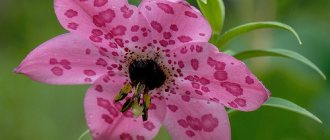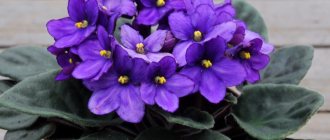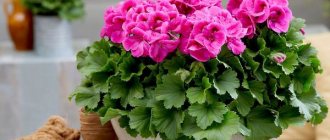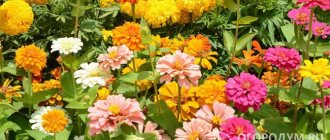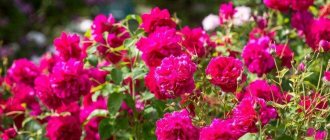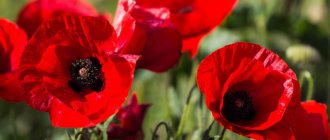Tolmiea flower
Family Saxifraga
Tolmia forms a compact (up to 22 cm tall) bush of pubescent bright green leaves. At the base of adult leaves, suckers are formed. This is one of the hardiest indoor plants and thrives in a cool, well-ventilated area away from direct sunlight. Hot and dry air is destructive for her.
Types of indoor plants
T. menziesii (T. Menzies) is the most common plant that produces shoots on the leaves. She is extremely unpretentious. Due to the long petioles of the leaves it looks like a hanging plant.
- Temperature:
Moderate or slightly below moderate, in winter not lower than 6°C. - Lighting:
Prefers bright light, can also grow in the shade. - Watering:
Abundant, the soil should remain moist at all times; In winter, watering is reduced. - Air humidity:
Leaves should be sprayed from time to time. - Replanting:
Every year in spring. - Reproduction:
The offspring are covered with earth; After rooting, the stems are cut off.
Torenia
Flower starting with the letter T - complete alphabetical list online
| Tobacco | Sweet tobacco |
| Spiraea | Meadowsweet |
| Waist whitish | Tanacetum |
| Tecomaria cape | Common telores |
| Tetrastigma of Voinier | Common thyme |
| Tlaspi | Tolmia |
| Crassula arborescens | Crassula carpet |
| Crassula moss | Jerusalem artichoke (earthen pear) |
| Tradescantia | White-flowered Tradescantia |
| Tradescantia Blossfelda | Tradescantia navicularis |
| Tradescantia riverine | Trachelium |
| Trachelospermum jasminoides | Trachycarpus |
| Trillium grandiflora | Trichocereus brilliantus |
| Trichocereus Paciano | Trichocereus Spach |
| Tromsdorfia spotted | Japanese arborvitae |
| Thumia paperthorn | Thunbergia fragrant |
| Thunbergia winged | Turbinicarpus macrospinous |
| Turbinicarpus lophophoroides | Turbinicarpus Schmiedicke |
| Thuja | Yarrow |
| Yarrow | Tulip |
| Tulip hybrid |
kupidonia.ru
Shrub with red sour berries.
List of plants starting with the letter “x”
It is interesting that the words cranberry and spreading cranberry as a common noun for all kinds of absurdity and nonsense are attributed to B.F.
Vasilisa kept order in the Cranberry swamp entrusted to her, but while the cranberries were blooming, there was absolutely nothing to do in the swamp.
On the road, everything is measured in kilometers: twenty-two - a swamp, cranberries; thirty-ninth - old bridge, dismantled road; forty-seventh - the road to the city, the opportunity to sell at least something to passers-by: cranberries, potatoes, squirrel mittens.
And then the fish will appear, it’s generally easier in the summer, the cranberries will grow, but they will suffer from scurvy - they are afraid of cranberries like fire.
You see, he’s snacking on cranberries, which means he’s been drinking for a long time... I know he doesn’t eat anything, just vodka and cranberries.
Artificially grown cranberries are much larger than ordinary cranberries growing in the swamp; individual berries reach the size of cherries.
It was later that they nicknamed Zhuravlin, when during a drawing lesson Isidor Semyonovich showed a drawing where a cranberry was depicted and asked what the name of such a berry was.
For weight, it is added, although besides it there is a lot more: the cabbage itself, covered with skulls; loose apples in a convenient piece, which is why they are easily swallowed, as if he himself had regurgitated them first; also cranberries and even grapes.
T
List of plants starting with the letter n: indoor, garden and vegetable plants
Meadowsweet or spirea (lat. Spiraea)
Meadowsweet (lat. Spiraea) belongs to the rose family (lat. Rosaceae) and is a perennial flowering shrub. The stem branches well and responds well to formative pruning.
(lat. Spirea japonica)
This type of meadowsweet is decorative in everything. Its stem is pubescent, with a ribbed or striped texture of a reddish color.
Tamarix (lat. Tamarix) Tamarix (lat. Tamarix) belongs to the Tamarix family (lat. Tamaricaceae) and is a perennial tree-like shrub. The shape of the bush structure, leaves, and inflorescences are also decorative.
(lat. Thelocactus)
The genus Telocactus (lat. Thelocactus) unites about 10 species. It belongs to the large Cactus family (lat. Cactaceae). The homeland of Telocactus is Mexico. The most common four species of Telocactus are found in culture. But most often, gardeners grow Telocactus setispinus (lat. Thelocactus (Hamatocactus) setispinus).
Telocactus setispinus (Telocactus setispinus) (lat. Thelocactus setispinus, Hamatocactus setispinus)
Tetrastigma (lat. Tetrastigma voineriana)
Tetrastigma Voineriana, Voinier Grape (lat. Tetrastigma voineriana) belongs to the Grape family (lat. Vitaceae) and is a large perennial vine with powerful stems and young shoots.
Tetrastigma Voinierianum (lat. Tetrastigma voinierianum)
Tephrocactus jointed (lat. Tephrocactus)
Tillandsia (lat. Tillandsia)
Many representatives of the Tillandsia species use their roots not to absorb useful substances from the soil, but only as a way of attaching to trees and stones, and they receive everything they need for their development through the leaves. It is these flowers that are called atmospheric or gray tillandsias.
Tillandsia Linden (lat. Tillandsia lindenii)
Tillandsia blue (lat. Tillandsia cyanea)
Tillandsia usneoide (lat. Tillandsia usneoide)
Tillandsia usneoide belongs to the Bromeliaceae family (Latin Bromeliaceae) and is a herbaceous perennial plant. This type is considered the most common.
Tradescantia (Setkresia, Zebrina, Woman's Gossip) (lat. Tradescantia)
Caring for a Tradescantia flower requires good lighting. She can feel great both in partial shade and in the sun. But the plant has some peculiarities.
see also:
Homeland of Tradescantia
White-flowered Tradescantia (Tradescantia tricolor, Tradescantia uridis) (lat. Tradescantia albiflora)
Tradescantia Blossfeldiana (lat. Tradescantia blossfeldiana)
Tradescantia variegated (Rheo) (lat. Rhoeo discolor, Tradescantia spathacea)
Trachycarpus (lat. Trachycarpus)
Trachycarpus do not like direct sunlight, so the optimal lighting for them will be diffused light or shade. Since palm leaves grow faster on the side exposed to the sun, the plant needs to be rotated once every two weeks.
Trachycarpus fortunei (lat. Trachycarpus fortunei)
Brazilian Trithrinax (lat. Trithrinax brasiiensis)
Thunbergia (lat. Thunbergia)
This wonderful liana came to us from the tropical countries of Asia and Africa, where 200 species of thunbergia are found. There are several varieties of the plant: fragrant, large-flowered, erect, Vogel's thunbergia and winged thunbergia.
Winged Thunbergia (lat. Thunbergia alata)
Thunbergia erecta (lat. Thunbergia erecta)
Turbinicarpus (lat. Turbinicarpus)
Turbinicarpus (lat. Turbinicarpus) belongs to the Cactus family (lat. Cactaceae) and is a perennial succulent. Its stem reaches a diameter of 5 cm and is decorated with large tubercles and spines that are strongly curved.
Turbinicarpus schmiedickeanus (lat. Turbinicarpus schmiedickeanus)
Large-spined turbinocarpus (lat. Turbinicarpus macrochele)
Thuja (lat. Thuja)
Thuja tolerates a shaded place well, but if there is too little light, it may begin to lose the splendor of its forms. The rays of the sun directly falling on the leaves of the thuja can cause burns, so the best environment for the thuja is a place with abundant but diffused light. You can place the thuja on a small table in front of the window.
Tulip (lat. Tulipa)
Tulips are able to grow in a wide temperature range from 2°C to 30°C; at the beginning of growth they tolerate temperatures of -18°C.
A B C D E F G H I K L M N O P R S T U V
List of plants starting with the letter "T"
Meadowsweet or spirea (lat. Spiraea)
Meadowsweet (lat. Spiraea) belongs to the Rose family (lat. Rosaceae) and is a perennial flowering shrub. The stem branches well and responds well to formative pruning.
The genus Telocactus (lat. Thelocactus) unites about 10 species. It belongs to the large Cactus family (lat. Cactaceae). The homeland of Telocactus is Mexico. The most common four species of Telocactus are found in culture. But most often, gardeners grow Telocactus setispinus (lat. Thelocactus (Hamatocactus) setispinus).
Telocactus setispinus (Telocactus setispinus) (lat. Thelocactus setispinus, Hamatocactus setispinus)
Tetrastigma (lat. Tetrastigma voineriana)
Tetrastigma Voineriana, Voinier Grape (lat. Tetrastigma voineriana) belongs to the Grape family (lat. Vitaceae) and is a large perennial vine with powerful stems and young shoots.
Tetrastigma Voinierianum (lat. Tetrastigma voinierianum)
Tephrocactus jointed (lat. Tephrocactus)
Tillandsia (lat. Tillandsia)
Many representatives of the Tillandsia species use their roots not to absorb useful substances from the soil, but only as a way of attaching to trees and stones, and they receive everything they need for their development through the leaves. It is these flowers that are called atmospheric or gray tillandsias.
Tillandsia Linden (lat. Tillandsia lindenii)
Tillandsia blue (lat. Tillandsia cyanea)
Tillandsia usneoide (lat. Tillandsia usneoide)
Tillandsia usneoide belongs to the Bromeliaceae family (Latin Bromeliaceae) and is a herbaceous perennial plant. This type is considered the most common.
Tradescantia (Setkresia, Zebrina, Woman's Gossip) (lat. Tradescantia)
Caring for a Tradescantia flower requires good lighting. She can feel great both in partial shade and in the sun. But the plant has some peculiarities.
White-flowered Tradescantia (Tradescantia tricolor, Tradescantia uridis) (lat. Tradescantia albiflora)
Tradescantia Blossfeldiana (lat. Tradescantia blossfeldiana)
Tradescantia variegated (Rheo) (lat. Rhoeo discolor, Tradescantia spathacea)
Trachycarpus (lat. Trachycarpus)
Related article: Fruit trees and berry bushes: names, photos, cultivation
Trachycarpus do not like direct sunlight, so the optimal lighting for them will be diffused light or shade. Since palm leaves grow faster on the side exposed to the sun, the plant needs to be rotated once every two weeks.
Trachycarpus fortunei (lat. Trachycarpus fortunei)
Brazilian Trithrinax (lat. Trithrinax brasiiensis)
Thunbergia (lat. Thunbergia)
This wonderful liana came to us from the tropical countries of Asia and Africa, where 200 species of thunbergia are found. There are several varieties of the plant: fragrant, large-flowered, erect, Vogel's thunbergia and winged thunbergia.
Winged Thunbergia (lat. Thunbergia alata)
Thunbergia erecta (lat. Thunbergia erecta)
Turbinicarpus (lat. Turbinicarpus)
Turbinicarpus (lat. Turbinicarpus) belongs to the Cactus family (lat. Cactaceae) and is a perennial succulent. Its stem reaches a diameter of 5 cm and is decorated with large tubercles and spines that are strongly curved.
Turbinicarpus schmiedickeanus (lat. Turbinicarpus schmiedickeanus)
Large-spined turbinocarpus (lat. Turbinicarpus macrochele)
Thuja (lat. Thuja)
Thuja tolerates a shaded place well, but if there is too little light, it may begin to lose the splendor of its forms. The rays of the sun directly falling on the leaves of the thuja can cause burns, so the best environment for the thuja is a place with abundant but diffused light. You can place the thuja on a small table in front of the window.
Tulip (lat. Tulipa)
Tulips are able to grow in a wide temperature range from 2°C to 30°C; at the beginning of growth they tolerate temperatures of -18°C.
Tetrastigma flower
Family Grape
Coniferous plants for the garden and dacha: catalog of plants with descriptions
The main decoration of the tetrastigma is leaves covered with dense brown hairs. They consist of 3-5 lobes and reach 25 cm in diameter. The edges of the leaf blades are serrated. Young shoots and tendrils are also densely pubescent. Overall, Tetrastigma is a very attractive plant. If you decide to develop tetrastigma, consider how you will limit its growth. A rejuvenating haircut, removal of part of the roots during replanting, and keeping them in close quarters will help you. We do not recommend restricting tetrastigma in nutrition: this causes the leaves to become smaller and less attractive, and the number of leaf lobes decreases. If you can provide a high temperature (20-25°C), then propagation of tetrastigma by cuttings can be carried out all year round. A fragment of a stem with a single leaf and an axillary bud will be sufficient. When planting in a mixture for cuttings, the bud must be above the substrate, otherwise a new shoot will not form. Rooting lasts about a month. After this, transplant the young plant into a mixture of sand, compost and turf soil in equal proportions. Provide support for the growth of tetrastigma, or use it as an hanging plant. Tetrastigma prefers bright, diffused light and regular watering. Tolerates dry air relatively easily. Tetrastigma is damaged by aphids, spider mites, and nematodes. Tillandsia
Tillandsia flower
Family Bromeliads
Unfortunately, only tillandsias are offered in stores. The most common is Tillandsia usneiformes. In appearance, it bears little resemblance to a flowering plant. The greenish-gray densely intertwined twigs represent a complex branched system of shoots with tiny rosettes of leaves. This plant is much closer in appearance to lichens: in humid areas of the USA and Mexico, it hangs abundantly from all objects on which it managed to settle. There is no need to specially strengthen the tillandsia on a support; it is enough to hang it, providing the opportunity to grow downwards. The rest of the tillandsias are more like bulbs with tightly closed leaf bases that bend to the side only at the top. The bulbous part accumulates moisture flowing from the leaf blades. The size of the leaves and their shape determine the appearance of each species. Thus, in Tillandsia “Medusa’s head” the bases of the leaves are wide and their ends are curled. The grayish color and serpentine leaf blades reminded botanists of the myth of the Gorgon Medusa, after whom this plant was named. In nature, this tillandsia lives in symbiosis with ants, which supply it with minerals and in return receive good protection and water. During flowering, an inflorescence appears from the “bulb” bearing blue flowers against a bright red background of bracts. Tillandsia violetflower has narrower, curved, but not curled leaves and reaches a height of only 5 cm. As the name suggests, the flowers are lilac in color. The bracts are red. Tillandsia silver has narrow plates that suddenly widen towards the base. They are curved and extend from the “onion” in disarray.
Tolmia
Torenia flower
Family Norichinaceae
This annual plant blooms in summer and can be placed on a windowsill. Grown from seeds, which the flower is sown in early spring. The stems quickly stretch out; to enhance branching, their ends are pinched and supported. The flowers are very distinctive: the corolla is lilac, with a dark purple lower lip and a bright yellow spot. The plant is unpretentious - keep it in a well-lit place, water it regularly and avoid drafts.
Types of indoor plants
T. fournieri (T. Fournier) is a compact bush, when tied to a support it reaches a height of 25-30 cm. Suitable for placement in a hanging basket. The cultivated forms include alba (pure white flowers) and grandiflora (larger and more numerous flowers).
Secrets of success in flower care
- Temperature:
Moderate, approximately 12-20°C. - Lighting:
Bright diffused light. - Watering:
Abundant. - Air humidity:
Leaves should be sprayed from time to time. - Care after flowering:
The plant is thrown away. - Reproduction:
By seeds in spring.
Tradescantia
Food products (alphabetically):
Do you know that:
According to WHO research, talking on a mobile phone for half an hour every day increases the likelihood of developing a brain tumor by 40%.
In order to say even the shortest and simplest words, we use 72 muscles.
Each person has not only unique fingerprints, but also tongue prints.
During operation, our brain expends an amount of energy equal to a 10-watt light bulb. So the image of a light bulb above your head at the moment an interesting thought arises is not so far from the truth.
The human stomach copes well with foreign objects without medical intervention. It is known that gastric juice can even dissolve coins.
Many drugs were initially marketed as medicines. Heroin, for example, was originally brought to market as a cure for children's coughs. And cocaine was recommended by doctors as an anesthesia and as a means of increasing endurance.
If your liver stopped working, death would occur within 24 hours.
Human blood “runs” through the vessels under enormous pressure and, if their integrity is violated, it can shoot at a distance of up to 10 meters.
In 5% of patients, the antidepressant Clomipramine causes orgasm.
According to many scientists, vitamin complexes are practically useless for humans.
People who eat breakfast regularly are much less likely to be obese.
Our kidneys are capable of purifying three liters of blood in one minute.
74-year-old Australian resident James Harrison has donated blood about 1,000 times. He has a rare blood type whose antibodies help newborns with severe anemia survive. Thus, the Australian saved about two million children.
Millions of bacteria are born, live and die in our intestines. They can only be seen under high magnification, but if they were put together, they would fit in a regular coffee cup.
The first vibrator was invented in the 19th century. It was powered by a steam engine and was intended to treat female hysteria.
Woody plant without a main trunk.
Indian - evergreen (or semi-evergreen) shrub with beautiful bright flowers (the corolla is pure white, pink, red or variegated). Lit.: Trees and shrubs of the USSR, vol.
Among the bushes there were orange dodder flowers, clinging to the stems of neighboring plants that were dying from these embraces, but the bush was thick and plentiful.
There is protection all around: on one side there is a humpbacked rocky cape, on the other there is a chain of shallows densely overgrown with bushes and reeds, on the rear there are bushes and an impenetrably dark thicket of high forest.
I remember that we drove for an eternity, that there were countless fields, some hollows, country roads, and crossroads, and that on the road this is what happened: in one hollow—and it was already evening and the places were very remote—there were thick trees an oak bush, dark green and curly, and along its opposite slope a “robber” was making his way among the bushes, with an ax tucked into his belt - perhaps the most mysterious and terrible of all the men I had seen not only up to that time, but also in general throughout my entire life.
Grass turns into thickets gradually, thickets become bushes, bushes become trees, tenacious mustaches grab onto branches, vines crawl along trunks, Ashi takes a few more steps - and the jungle closes in behind him, above his head.
It is all dotted with heaps of low-growing trees, or rather bushes, scorched by the sun in summer and bare in winter; The bushes are brown - everything here is brown, right up to the very mountains, where there are gray, silvery and yellowish shadows, like freshly cut forest.
In the center stood an old tree with a straight, ashen trunk, around which large and small bushes grew, and in the thickets of bushes there were various herbs and different colors.
At first she saw only the blue sky, then yellow-leaved bushes and, against the background of bushes, caps and hats with folding headphones, above which the ends of the vines flew up.
I remember that we drove for an eternity, that there were no number of fields, some hollows, country roads, intersections, and that on the road this is what happened: in one hollow—and it was already evening and the places were very remote—there were thick trees an oak bush, dark green and curly, and along its opposite slope a “robber” was making his way among the bushes, with an ax tucked into his belt - perhaps the most mysterious and terrible of all the men I had seen not only up to that time, but and in general throughout my life.
Encyclopedia of gardening, floriculture and landscape design
Tobacco - Herbaceous plants for open ground Tobacco Sander - Herbaceous plants for open ground Tobacco Sander - Herbaceous plants for open ground Close tobacco - Herbaceous plants for open ground Winged tobacco - Herbaceous plants for open ground Forest tobacco - Herbaceous plants for open ground Changeable tobacco - Herbaceous plants for open ground Meadowsweet - Ornamental trees and shrubs Meadowsweet - Herbaceous plants for open ground Meadowsweet Boumalda - Ornamental trees and shrubs Meadowsweet Vangutta - Ornamental trees and shrubs Douglas meadowsweet - Ornamental trees and shrubs Meadowsweet Thunberg - Ornamental trees and shrubs White meadowsweet - Ornamental trees and shrubs Birch-leaved meadowsweet - Ornamental trees and shrubs Elm-leaved meadowsweet - Herbaceous plants for open ground Oak-leaved meadowsweet - Ornamental trees and shrubs St. John's meadowsweet - Ornamental trees and shrubs Willow-leaved meadowsweet - Ornamental trees and shrubs Fine-toothed meadowsweet - Ornamental trees and shrubs Nippon meadowsweet - Ornamental trees and shrubs Meadowsweet - Herbaceous plants for open ground Meadowsweet six-petalled - Herbaceous plants for open ground Japanese meadowsweet - Ornamental trees and shrubs Tagetes - Herbaceous plants for open ground Thai melon - Vegetable crops Tamarix - Ornamental trees and shrubs Tamarix Meyer - Ornamental trees and shrubs Tamarix branched - Ornamental trees and shrubs Tamarix graceful - Ornamental trees and shrubs Tamarix multibranched - Ornamental trees and shrubs Tamarix five-stamen - Ornamental trees and shrubs Tamarix four-stamen - Ornamental trees and shrubs Tanacetum maidens - Herbaceous plants for open ground Plate pumpkin - Vegetables Tarragon — Vegetable crops Tecoma — Telekia creepers — Herbaceous plants for open ground Telekia beautiful — Herbaceous plants for open ground Telekia beautiful — Herbaceous plants for open ground Telipteris — Plants for ponds Telipteris — Herbaceous plants for open ground Telipteris marsh — Herbaceous plants for open ground Telocactus — Indoor plants Telocactus setispinus — Indoor plants Telocactus setispinosus — Indoor plants Telorez — Plants for ponds Telocactus aloeides — Plants for ponds Thermopsis — Herbaceous plants for open ground Thermopsis naked — Herbaceous plants for open ground Thermopsis dahurian — Herbaceous plants for open ground Thermopsis lanceolata — Herbaceous plants for open ground Thermopsis lanceolate - Herbaceous plants for open ground Thermopsis Siberian - Herbaceous plants for open ground Tetragony - Vegetable crops Tetrastigma - Indoor plants Tetrastigma Voignier - Indoor plants Mother-in-law's tongue - Indoor plants Mother-in-law's tongue - Indoor plants Tiarella - Herbaceous plants for open ground soil Tiarella cordifolia - Herbaceous plants for open ground Tiarella cordifolia - Herbaceous plants for open ground Tibetan orchid - Indoor plants Tigridia - Herbaceous plants for open ground Tigridia peacock - Herbaceous plants for open ground Tiger bromeliad - Indoor plants Tillandsia - Indoor plants Tillandsia blue - Indoor plants plants Tillandsia usneiformes - Houseplants Till - Vegetable crops Timon - Vegetable crops Thyme - Vegetable crops Thyme - Herbaceous plants for open ground Lemon-smelling thyme - Herbaceous plants for open ground Thyme common - Herbaceous plants for open ground Creeping thyme - Herbaceous plants for open ground Yew — Ornamental trees and shrubs European yew — Ornamental trees and shrubs Common yew — Ornamental trees and shrubs Acute yew — Ornamental trees and shrubs Medium yew — Ornamental trees and shrubs Yew berry — Ornamental trees and shrubs European yew — Ornamental trees and shrubs Common yew — Ornamental trees and shrubs Acute yew - Ornamental trees and shrubs Medium yew - Ornamental trees and shrubs Berry yew - Ornamental trees and shrubs Tladianta - Vegetable crops Caraway - Vegetable crops Crassula - Indoor plants Crassula tree-like - Indoor plants Crassula mossy - Indoor plants Crassula lycophyte - Indoor plants Crassula purslane - Indoor plants Crassula crescent - Indoor plants Crassula tetrahedral - Indoor plants Tomato - Vegetable crops Mexican tomato - Vegetable crops Jerusalem artichoke - Vegetable crops Topo-tono Venezuelan - Vegetable crops Poplar - Ornamental trees and shrubs Balsam poplar - Ornamental trees and shrubs White poplar - Ornamental trees and shrubs Berlin poplar - Ornamental trees and shrubs Sweet poplar - Ornamental trees and shrubs Canadian poplar - Ornamental trees and shrubs Pyramid poplar - Ornamental trees and shrubs Silver poplar - Ornamental trees and shrubs Black poplar - Ornamental trees and shrubs Torenia — Herbaceous plants for open ground Torenia Fournier — Herbaceous plants for open ground Herb for roast — Vegetable crops Tragopogon — Vegetable crops Tradescantia — Indoor plants Tradescantia — Plants for ponds Tradescantia — Herbaceous plants for open ground Tradescantia Anderson — Herbaceous plants for open ground Tradescantia Blossfeld — Indoor plants Tradescantia white-flowered — Indoor plants Tradescantia virginiana — Herbaceous plants for open ground Tradescantia navicularis — Indoor plants Tradescantia purpurifolia — Indoor plants Tradescantia tricolor — Indoor plants Tradescantia uridis — Indoor plants Trachycarpus — Indoor plants Trachycarpus fortunena — Indoor plants Three-stem plant — Herbaceous plants for open ground Three-stemmed pinnately cut - Herbaceous plants for open ground Trefoil - Creepers Regel's three-wing - Creepers Tricolor chamomile - Herbaceous plants for open ground Tricolor chrysanthemum - Herbaceous plants for open ground Water trefoil - Plants for ponds Trillium - Herbaceous plants for open ground Trillium Kamchatka - Herbaceous plants for open ground Trillium grandiflora - Herbaceous plants for open ground Trillium erecta - Herbaceous plants for open ground Trillium rhombifolia - Herbaceous plants for open ground Tritoma - Herbaceous plants for open ground Tritonia - Herbaceous plants for open ground Tritonia garden - Herbaceous plants for open ground Trifol - Plants for ponds Trichozant - Vegetable crops Tritsirtis - Herbaceous plants for open ground Tritsirtis latifolia - Herbaceous plants for open ground Trollius - Herbaceous plants for open ground Reed - Plants for ponds Common reed - Plants for ponds Southern reed - Plants for ponds Archangel's trumpets — Indoor plants Hemlock — Ornamental trees and shrubs Canadian hemlock — Ornamental trees and shrubs Hemlock — Ornamental trees and shrubs Hemlock chisel — Ornamental trees and shrubs Hemlock drooping — Ornamental trees and shrubs Hemlock pluriform — Ornamental trees and shrubs Hemlock japonica — Ornamental trees and shrubs Thunbergia - Lianas Thunbergia - Indoor plants Thunbergia winged - Lianas Thunbergia winged - Indoor plants Thunbergia erecta - Indoor plants Turbinicarpus - Indoor plants Turbinicarpus schmidikkeanus - Indoor plants Turkish beans - Lianas Turkish beans - Herbaceous plants for open ground Turkish mullein - Herbaceous plants for open ground Turcha - Plants for ponds Turcha swamp - Plants for reservoirs Turcha swollen - Plants for reservoirs Thuja - Ornamental trees and shrubs Thuja occidentalis - Ornamental trees and shrubs Pumpkin - Lianas Pumpkin - Vegetable crops Pumpkin - Herbaceous plants for open ground Fragrant pumpkin - Vegetable crops Pumpkin decorative - Lianas Large-fruited pumpkin - Vegetable crops Small-fruited pumpkin - Lianas Loofah pumpkin - Vegetable crops Muscat pumpkin - Vegetable crops Common pumpkin - Vegetable crops Common figured pumpkin - Lianas Vegetable pumpkin - Vegetable crops Hard-barked pumpkin - Vegetable crops Pumpkin crops - Vegetable crops Yarrow - Herbaceous plants for open ground Yarrow - Herbaceous plants for open ground Yarrow ptarmika - Herbaceous plants for open ground Meadowsweet yarrow - Herbaceous plants for open ground Tulip - Herbaceous plants for open ground
Color names
On this page you can see the names of flowers and their photos. At the moment, the site contains articles on the care and cultivation of 150 of the most popular flowers. By going to the flower by letter page, you can see photos and names of more than 400 houseplants.
Names of flowers with photos
- adding new names;
- adding new photos;
- adding new varieties;
- adding new videos.
AbutiloneAglaonemaAdeniumAzaleaAlocasiaAloeAmaryllisAnthuriumAraucariaArdisiaAsparagusAspidistraAucubaBabmukBalsamBegoniaEveronymusGardeniaCarnationDahliasGeraniumGerberasHyacinthHibiscusHippeastrumGladiolusGloxiniaHydrangeaGuzmaniaDendrobiumDiffen bahiaDracaenaJasmineZamioculcasCactiKalanchoeCalatheaCallisiaCalceolariaCamelliaSaxifrageCatharanthusClerodendrumCliviaColeusCrocusCrotonLedeburiaLilyLemonArrowrootMonsteraNarcissusNepenthesNolinaOleanderOpuntiaOrchidsPandanusFernPassifloraPachistachisPepper IaPetuniaPeonyPrimulaPoinsettiaRadermacherRoseBoxwoodSansevieriaSelaginellaSpathiphyllumStephanotisStreptocarpusScindapsusTillandsiaCrassulaTradescantiaTulipsPhalaenopsisVioletsFicusPhilodendronFittoniaFreesiaFuchsiaHamedorrheaChlorophytumHoyaChrysanthemumCymbidiumCyper usSchefflerSchlumbergerEucharisEchmeaYucca florino.net
names of colors in alphabetical order from a to z
Flower names in alphabetical order by letter
Abutilon, indoor maple, ropeweedAgaveAgapanthus, African or Nile lilyAgeratumAglaonema, another article about AglaonemaAgrostemma, cockleAdenium, Desert roseAdiantum - fernAdonisAdromishusAzalea, rhododendronAzorellaAir, acorusAquilegia, columbine, eagleAconite, wrestler, lumbago-grassA ctinidia - lianaAlyssum, alyssumAllamandaAlocasiaAloe, agaveAltheaAlpiniaAlsobiaAlstroemeriaAmaranthAmaryllisAmorphaAmsoniaAnemone, anemoneAnigozanthosAntennaria, cat's pawAnthuriumPansyAporocactusAraliaAraucariaArbutus , strawberry Argyroderma Ardisia Areca, betel Arizema Armeria Arum Asparagus, asparagus Aspidistra, friendly family Asplenium, bone fern Astilbe Astilboides Astra Astra annual, callistephus Astrantia, star Astrophytum Aucuba, golden tree Aurinia, hiccup Aphelandra Achimenes price Acidanthera, fragrant gladiolusAerides - orchid Crimson, roundleaf Ledum, ledumBadan, BergeniaImpatiens, impatiens, impatiens
- Bamboo
- Periwinkle, vinca
- Velvet, phellodendron
- Marigolds, tagetes. How to grow them
- Begonia
- Colchicum, Colchicum
- Butterbur
- Whiteflower
- Euonymus
- Euonymus, pseudolaurel
- Bertolonia
- Crazy cucumber, thorny liana
- Bilbergia
- Privet
- Blekhnum, derbyanka - fern
- Bobovnik
- Bovieya
- Beaucarneya, nolina
- Borage, borage, borage
- Brandushka, Bulbocodium
- Brachychiton
- Browallia
- Brunner, forget-me-not
- Brunfelsia
- Cowberry
- Bell, adenophora
- Bougainvillea
- Buddleya
- Budra, glekhoma
- Buzulnik, ligularia
- Initial letter, Betonika
- Valerian
- Waldsteinia
- Vanda - orchid
- cornflower
- Basilisk
- Vatochnik, asklepias, lastoven
- Watch, shamrock
- Washingtonia
- Weigela
- Loosestrife
- Verbena
- Heather
- Veronica
- Vesennik, erantis
- Vechernitsa
- Grape
- Vineyard, ampelopsis
- Cherry
- Volzhanka
- Wolfman, wolfberry, daphne
- sparrow
- Voronets, Akteya
- Vriesia, Vriesia
- Elm - bonsai
- Elm, elm, birch bark
- Bindweed, convolvulus
- Gaillardia
- Witch hazel
- Gardenia
- Gasteria
- Gatsania
- Carnation
- Heuchera
- Helenium
- Heliconia
- Heliotrope
- Helipterum
- Hemanthus
- Geogenanthus
- Dahlia
- Geranium
- Gerbera, "Transvaal daisy"
- Heteropanax
- Hyacinth
- Hymenocallis, Pancratium
- Gymnocalycium - cactus
- Ginkgo
- Ginura
- Hypocyrta
- Hypoestes
- Hippeastrum
- Gypsophila
- Gladiolus
- Gloriosa
- Godetia
- Gymnocarpium - fern
- Blueberry
- Gomphrena
- Highlander
- Gentian, gentiana
- Hydrangea, hydrangea
- Goryanka
- Avens
- Pomegranate
- Grevillea, silk oak
- Pear
- Lipstick, mimulus
- Guzmania, Guzmania
- Goose onion, gagea
- Davallia - fern
- Maiden grape, parthenocissus - liana
- Elecampane
- Deytsia
- Delphinium, spur
- Dendrobium - orchid
- Loosestrife
- Derain, svidina, cornus, dogwood
- Jeffersonia
- Dizygoteka
- Dixonia - fern
- Dimorphotheca
- Dipladenia, Mandevilla
- Dieffenbachia
- Di
- Doritenopsis - orchid
- Doronicum
- Dracaena
- Drimiopsis
- Gorse
- Drakvennik, dodecatheon
- Datura
- Oregano, origanum
- Blackberry
- Spruce
- Jasmine
- Tenacious
- Honeysuckle
- Zhiryanka
- Haretail, lagurus
- Zamioculcas
- Zamia
- Zantedejia, Calla
- St. John's wort
- Zebrina
- Zelenchuk
- Strawberries, strawberries
- Zephyranthes, upstart
- Zygadenus
- Zygocactus, Decembrist, Schlumbergera
- Zygopetalum - orchid
- Goldenrod, solidago
- Denticula, dentarium
- Iberis, stennik
- Willow
- Ixiolirion
- Ixia
- Ixora
- Incarvillea
- Morning glory, farbitis
- Irga
- Irezine
- Iridodictium
- Iris
- Hyssop
- Caladium
- Kalanchoe, bryophyllum
- Calathea
- Calendula, marigold
- Calibrachoa, mini petunia
- Calicanthus, calyx flower
- Kalina
- Callisia, golden mustache
- Callistemon
- Kaluzhnitsa
- Kalmiya
- Calceolaria
- Camassia
- Camellia
- Saxifrage
- Reed, Isolepis, Scirpus
- Kandyk, erythronium
- Canna
- Karagana
- Cardiocrinum
- Carissa
- Carmona, Erecia
- Cassia, Senna
- Catalpa
- Catharanthus, periwinkle, lochnera
- Cattleya - orchid
- Chestnut seed plant
- Kermek, statice, limonium
- Kerria, Keriya
- cotoneaster
- Cypress
- Cypress
- Kirkazon
- Oxalis, oxalis
- Clarkia
- Cleistocactus
- Klekachka, swollen nut
- Clematis, clematis
- Maple
- Cleome, cleome
- Clerodendrum
- Castor bean
- Clivia
- Strawberry
- Cranberry
- Knifofia
- Kobeya
- Feather grass
- Codiaum, croton
- Codonanta
- Codonopsis
- Coconut
- Coleostephus
- Koleria, Isoloma, Tydea
- Coleus
- Coleus, poor man's croton, nettle
- Bell
- Columnea
- Kolkvitsia
- Commelina
- horse chestnut
- Kopyten
- Cordilina
- Coreopsis
- Corynocarpus
- Mullein
- Space
- Kostenets, asplenium - fern
- Costus
- Catnip, catnip
- Coffee, coffee tree, arabica
- Kochia
- Kochedyzhnik - fern
- Raspberry, Cineraria, Senecio
- Cryptanthus, earth star
- Cryptomeria
- Burnet
- Crocosmia
- Crocus, saffron
- Gooseberry
- Ktenanta
- Kubyshka
- Water lily, nymphea, water lily
- Pitcher plant, Nepenthes
- Bathing suit, bathing, lights, frying
- Kupena, "Solomon's seal"
- Kuril tea, cinquefoil
- Kufeya
- Meadowsweet
- Lavender
- Lavatera
- Laurel
- Lakonos, phytolacca
- Lily of the valley
- Lantana
- Lachenalia
- Quinoa, Atriplex
- Ledeburia
- Lelia - orchid
- Linen
- Leptospermum, tea tree
- Forest poppy
- Hazel, hazel
- Liatris
- Liviston
- Lysiheaton
- Lycaste - orchid
- Daylily, red daylily
- Lily
- Schisandra, schizandra
- Leaflet - fern
- Lithops, living stone
- Lychnis
- Lobelia
- Lobularia
- Ludisia, Ludisia - orchid
- Louiseania
- Onion
- Lunnik, lunnaria
- Lupine
- Buttercup, ranunculus
- Snapdragon, antirrhinum
- Toadflax
- Magnolia
- Mahonia
- Poppy
- Macleya
- Makodes - orchid
- Raspberries
- Standard raspberries
- Mammillaria
- Cuff
- Maranta
- Daisy
- Masdevalia, masdevallia - orchid
- Mattiola, Levkoy
- Medinilla
- Lungwort
- Mesembryanthemum
- Meconopsis
- Small petal, erigeron
- Melocactus
- Mikania, indoor ivy
- Microbiota
- Miltonia - orchid
- Almond
- Mirabilis, Night Beauty
- Myrtle, myrtle tree
- Miscanthus
- Mihenia
- Centipede - fern
- Centipede, Polypodium
- Multi-row, multi-tier - fern
- Juniper
- Youthful, tenacious
- Spurge
- Monarda
- Monstera
- Mordovnik
- Hellebore, heleborus
- Murraya, Muraya
- Muscari, mouse hyacinth, viper onion
- flycatcher
- Bryozoan, Saginah
- Soapwort
- Mühlenbeckia
- Mint
- Digitalis
- Narcissus
- Nasturtium
- Forget-me-not
- Nemesia
- Nemophila
- Neodypsis, Dipsis
- Neoregelia, Neoregelia
- Nepenthes
- Nerine
- Nertera, coral moss
- Nephrolepis - fern
- Nilet, popovnik, garden chamomile
- Nigella, nigella
- Nymphaeum, Whiteflower
- Sea buckthorn
- Aubrieta
- Odontoglossum - orchid
- Ozsika
- Comfrey
- Oleander
- Olive, Olive
- Onoclea - fern
- Oncidium - orchid
- Nut
- Bracken - fern
- Osmanthus
- Osmunda, chistoust - fern
- Sedge
- Ostyanka, Oplismenus
- Ophiopogon
- Sedum, sedum
- Holly, holly
- Paradise
- Parthenocissus
- Passionflower, passion flower
- Paphiopedilum, lady's slipper - orchid
- Pachysandra
- Pachypodium, Madagascar palm
- Pachira, Malabar chestnut
- Pachyphytum
- Pedilanthus
- Pelargonium, home geranium
- Pelleia - fern
- Pellionia
- Peltiphyllum, Darmera
- Pentas
- Peperomia
- Pepper
- Perilla
- Petunia
- Petunia mini
- Liverwort, coppice
- Pieris
- Pilea, artillery flower
- Peony
- Pyrethrum, pink chamomile
- Pistia, water salad
- Fir
- Platycodon, broadbell, valenberia
- Platycerium - fern
- Pleione - orchid
- Plectranthus, Swedish ivy
- Plumeria
- Ivy, Hedera
- Pogonaterum, indoor bamboo or reed
- Podbel, andromeda
- Podocarpus
- Podophyllum, podophyllum, podophyllum
- Snowdrop, galanthus
- Sunflower
- Polevichka
- Poliscias
- Sagebrush
- Pontederia
- Purslane
- Portulacaria
- Poskonnik
- Primrose, primrose
- Prinsepia, flatseed
- Scilla, Scylla
- Lumbago, sleep-grass, pulsatilla
- Pseudotsuga
- Pseuderanthemum
- Pteris, bracken - fern
- Ornithogalum, ornithogalum
- Bladderwort
- Navel, anthemis
- Umbilical cord, omphalodes
- Pushkinia
- Radermacher
- Broom
- Rhubarb
- Reo, tradescantia reo
- Rhipsalidopsis, Easter cactus
- Robinia, Acacia
- Rogersia
- Rhodiola
- Rhododendron
- Rose, rosehip
- Roycissus
- Sundew
- Rudbeckia
- Rousselia, coral plant
- Ruellia
- Rowan
- Fieldfare
- Hazel grouse, fritillaria
- Cycad, Cycas
- Salpiglossis
- Boxwood
- Sanvitalia
- Sansevieria, pike tail, mother-in-law's tongue
- Sarracenia
- Safflower
- Plumbago
- Selaginella, the resurrection plant
- Saintpaulia, Usambara violet
- Setcreasia
- Sidalcea
- Siderasis
- Syngonium
- Feverweed
- Sinningia, Gloxinia
- Sinyukha, polemonium
- Lilac
- Sitnik
- Scabiosa, widow, bark bark
- Skimmia
- Scopolia
- Mackerel, yellowberry
- Plum, Prunus
- Smilatsina
- Currant
- Snowberry
- Snooze
- Saltirolia, Gelksina, Helksina
- Solnechnik, Heliopsis
- Sunflower
- Sorbocotoneaster
- Pine
- Sophora
- Sparmannia, indoor linden
- Spathiphyllum
- Spiraea, meadowsweet
- Sprekelia, sprekelia
- Stapelia
- Stahis
- Stefanandra
- Stephanotis, Madagascar jasmine
- Ostrich - fern
- Strelitzia, bird of paradise
- Arrowhead
- Streptocarpus, stemmed violet
- Strobilanthes
- Stromanta
- Sumac
- Sutera, bacopa
- Schizanthus, schizanthus
- Scaevola
- Scindapsus, Epipremnum
- Scirpus
- Tobacco
- Takka, bat
- Tamarix, comber
- Tetrastigma
- Tiarella, tiarka
- Tillandsia, Spanish, Louisiana moss
- Thyme, thyme
- Tiss
- Tithonia
- Tladianta
- Tolmia
- Bearberry
- Thick-walled
- Crassula, crassula, money tree
- Torenia
- Tradescantia
- Trillium
- Tritsirtis
- Thunbergia
- Thuja
- Pumpkin
- Yarrow
- Tulip
- Uvularia
- Phalaenopsis - orchid
- Fatsia, Aralia
- Fatshedera
- Violet, viola
- Physalis, flashlight
- Physostegia
- Ficus
- Philodendron
- Date fruit
- Fittonia
- Phlox
- Forsythia
- Fortunella, kincan, kumquat
- Phragmipedium - orchid
- Fuchsia
- Haworthia
- Hakonechloa
- Hamedorea
- Chamelacium, wax myrtle
- Hathiora
- Houttuinia, huttinia, houtinia
- Hebe
- Helona
- Chaenomeles, Japanese quince
- Hirita
- Chlorophytum
- Hop
- Hovea, Kentia
- Hoya
- Hosta, funkia
- Corydalis
- Chrysanthemum
- Chrysanthemum, dendranthemum
- Ceanothus, Redroot
- Coelogina - orchid
- Celosia
- Celosia
- Cereus
- Ceropegia
- Tsercis
- Cyanotis
- Cyclamen
- Cyclamen, dryweed, alpine violet
- Cymbidium - orchid
- Cohosh
- Cineraria
- Zinnia
- Cyperus, satiate
- Cissus, indoor ivy, birch
- Citrus
- Bird cherry
- Blueberry
- Chernogolovka, prunella
- Chokeberry, chokeberry
- China, sweet pea
- Mock orange, garden jasmine
- Sage
- Mulberry, Here
- Scheffler
- Rose stock, mallow, mallow, alcea
- Setaria, bristlecone
- Shield plant, dryopteris - fern
- Eucalyptus
- Edelweiss
- Eichornia, water hyacinth
- Exakum
- Endymion
- Evening primrose, night candle, aspen tree
- Aeonium
- Epipremnum
- Episcia
- Epiphyllum
- Eremurus, shiryash
- Erika
- Eschynanthus
- Eucomis, eucomis
- Eustoma, lisianthus, Japanese rose
- Eucharis, Amazon lily
- Echeveria
- Echinocactus, hedgehog cactus
- Ekhmeya
- Eschszolzia
- Yucca
- Jacobinia
- Yasenets, burning bush
- Yasenets, burning bush
- Cerastium, cerastium
- Woodruff, asperula
- Woodruff, asperula
- Jatropha
tsvetem.ru
Flowers starting with the letter T – Flower Library
- Alphabetical index Flowers starting with the letter A
- Flowers starting with the letter B
- Flowers starting with the letter B
- Flowers starting with the letter G
- Flowers starting with the letter D
- Flowers starting with the letter E
- Flowers starting with the letter J
- Flowers starting with the letter Z
- Flowers starting with the letter I
- Flowers starting with the letter K
- Flowers starting with the letter L
- Flowers starting with the letter M
- Flowers starting with the letter N
- Flowers starting with the letter O
- Flowers starting with the letter P
- Flowers starting with the letter R
- Flowers starting with the letter C
- Flowers starting with the letter T
- Flowers starting with the letter U
- Flowers starting with the letter F
- Flowers starting with the letter X
- Flowers for the letters C, Ch, Sh, Shch
- Flowers for the letters E, Yu, Z
Flowers by category
- cacti
Indoor flowers Red Book of Flowers Shrubs and flowering trees Medicinal flowers Forest flowers Wild and meadow flowers Garden flowers Poisonous flowers Diseases and pests Interesting articles
- Alphabetical index
- Flowers by category
- Diseases and pests
- Interesting articles
New articles
- Types of bulbs
- Nectaroscordum
- Mullein
Flowers library / Flowers starting with the letter T Tobacco Meadowsweet Tevetia Tecomaria Cape Thyme Tolmia Jerusalem artichoke (Earth Pear) Tradescantia Tung Yarrow Tulip← Flowers starting with the letter CFlowers starting with the letter U →
List of all plants starting with the letter T (full catalog of names)
On this page, the Living Encyclopedia website is pleased to present to readers an encyclopedia of plants starting with the letter T. Here you will find a complete catalog (list) of all plants on planet Earth whose name begins with the letter T. To go to a detailed description of the plant you are interested in starting with the letter T, and also read literature about plants on T - click on the name of the desired plant.
Tobacco (plant) Sticky tobacco Winged tobacco Common tobacco Sander Tobacco Forgeta Tobacco tree Tabebuia Tabebuia white Tabernemontana Meadowsweet Meadowsweet meadowsweet Common meadowsweet Taiwan Cache (plant) Lily of the valley Cache Heart-shaped Cache Ovate Cache Takakia Takka Takka palmate Takka palmate incised Tacca Parkera Tacca pinnately incised Tacca wholeleaf Tacca Chantrier Taxandria Taxodiaceae Taxodiaceae (family) Taxodium Taxodium biseriata Taxodium mexicanis Talinaceae Talinum Tamarillo Tamarind Tamarisk leafless Tamariskaceae Tamarugo Tangelo Tapisciaceae
Taran (plant) Taran alpine Taro (plant) Tasmannia Tatarnik Tatarnik prickly Tau-sagyz Takhtajyaniananta Tahtajyaniya Tevetia Tekophyleaceae Telipteris Telipteris marsh Telipteris Telocactus Telopea Telopea faira Teloresis Theobroma Theophrastoceae Terminalia (plant) Thermopsis Thorn Turner's ilmofolia T Turnera spreading Turnereraceae Terpentine tree Tetragony Tetradyclis Tetracarpea Tetraclinis Tetramelaceae Tetramericaceae Tetrastigma Tetrachondraceae Teff Tephrosia Tiare Tiarella trifolia Thibodia Tigridia Tigridia peacock Teak (tree) Ticodendron Tillandsia Tillandsia usneiformes Tylophora Thymelea Timothy (plant) Meadow Timothy Sandy Timothy Steppe Timothy Thyme Thyme alatava skiy Baikal thyme Bashkir thyme Guberlin thyme Dnieper thyme Kalmius thyme Kyrgyz thyme Thyme bug Thyme Kochi Thyme pretty Thyme Marcothian Thyme Cretaceous Thyme Monetary Thyme Mugojar Thyme Common Thyme Creeping Thyme Pseudo-Monetary Thyme Early Thyme Talieva Thyme Hill Thyme Tineo (plant)
Fescue Tyrsopteris Yew Canadian Yew Short-leaved Yew Acute Yew Florida Yew Berry Yew Yew Titanopsis Tladiantha Tladiantha dubious Caraway Caraway whorled Cumin Common Caraway Caraway Caraway Armenian Caraway flattened Commodity Toddalia Toxicodendron Toxicodendron pilosa Toxi oriental codedendron Toxicodendron lacquer Toxicodendron fluffy Toxicodendron juicy Toxicodendron rooting Bearberry Alpine bearberry Common bearberry Crassula Crassula ovoid Crassula Tolumnia Tomandersia Tomato Cherry tomato Thin-legged Thin-legged Asian Thin-legged Delyavinya Thin-leaved hard-leaved Thin-leaved Thin-leaved Karavaeva Thin-leaved gray Thin-legged Talieva Thin-seeded Thin-legged prominent Thin-seeded smooth Thin-leaved istifolated Thin-leaved Thin-leaved continental Thin-leaved Thin-leaved large-leaved Thin-leaved Thin-seeded broom-shaped Thin-seeded world Thin seed juniper Thin seed inverted Peterson's thin seed Spreading thin seed Three-veined thin seed Jerusalem artichoke Poplar Balsam poplar Poplar white Berlin poplar Deltoid poplar Fragrant poplar Euphrates poplar Korean poplar Laurel-leaved poplar Maksimovich's poplar Moscow poplar Aspen poplar Pyramid poplar Variegated poplar Gray poplar Gray poplar Simon's poplar Black poplar Yunan poplar
Torica Torica Morison's Torica field Torichina Torichina red Torrhea Torrhea nucleifera Torricelliaceae Tofyldiaceae Tofyldia Tragus Tradescantia Tradescantia virginiana Tradescantia variegated Tradescantia sillamontana Traunsteinera globose Trachelium Trachycarpus Trebuxiophyceae Trebuxiaceae Tripod (plant) Trentepoly Tribordium chinensis Tricostal trio bernika odorless Tribeles Tridactylina Trillium (plant) Trillium Kamchatka Trimenia Triodanis marsh Triocrystus trichosantrum Trichocereus Triplochiton Tristagma Trithelia Triticale Tritonia Triumfetta Triuriaceae Trichoglottis Trichosanthus serpentine Trichocentrum Trichocereus Tricyrtis Tricyrtis short-haired Tricyrtis latifolia Trichaete Trichaete yellowish Trichaete spicata Reed Common reed Reed (plant) Trochetia Trochodendronaceae Trochodendron Trochocarpa Trochocarpa montana Trochocarpa Clarka Shaker Shaker large Shaker medium Hemlock Mountain hemlock Western Hemlock Canadian Hemlock Tsusiophyllum Tuberose Tuevik Tulasi Tulbagia Thunbergia Thunbergia grandiflora Tung Tunia Turbina (plant) Turbinicarpus Turnips Turniaceae Tournia Turrea Turcha Turcha marshes Mulberries Thuja Thuja occidentalis Thuja Korean Thuja plica Thuja Japanese Pumpkin Stinky Pumpkin Giant Pumpkin Palm Pumpkin Butternut Pumpkin Common pumpkin Figolifolia pumpkin Cucurbitaceae Cucurbitaceae Thousand-headed Yarrow Yarrow Arabian Yarrow Noble Yarrow Naked Yarrow Willow Yarrow Common Yarrow Ptarmika Yarrow Yarrow Bristle Tulip Bieberstein's Tulip Borschov's Tulip Tulip hairy-staminate Gesner's Tulip Greig's Tulip Tulip two-flowered Dwarf Tulip Tulle Pan Clusius Tulip Krause Tulip Lehman Tulip Forest Tulip Flax-leaved Tulip Orithium Tulip Late Tulip Drooping Tulip Superior Tulip Coastal tulip Doubtful tulip Four-leaf tulip Woolly tulip Broad-stamen tulip Schrenk's tulip
See information about plants of planet Earth in the catalog alphabetically:
* * * * * * * * * * * * * * * * * * * * * * * * * * * *
Flowers starting with the letter T. Photos and names of flowers and indoor plants starting with the letter T.
All flowers 362
Jasmine flowers are one of the genus of vine-shrubs of the olive family. Jasmine is a forever plant
Pests 265
Thrips (Fringedwings, Bladderwings) are a very common type of parasite. Thrips affect both decorative and indoor plants.
There are more than 35 thousand species and varieties of orchids in the world. This also includes
Video 474
Kalanchoe is a unique representative of the Crassulaceae family. It is known to be a medicinal plant, but few people
Photo galleries 556
The lovely lily is a very beautiful and unusual plant, but you must remember that it is poisonous and
All flowers 288
Clivia is a plant of the Amaryllis family. Clivia is native to the tropical rainforests of South Africa.
florino.net
Answers to the question Shrub starting with the letter T
- Blackthorn - (thorn) tree or shrub of the plum genus trees and shrubs 9 letters
- Solve crosswords
- Thorn - (thorn), a tree or shrub of the plum genus trees and shrubs 4 letters
- Blackthorn - A thorny shrub of the Rosaceae family with tart bluish-black fruits 9 letters
- Yew - Southern evergreen coniferous tree or shrub with valuable hardwood 3 letters
- Bearberry - A small shrub of the heather family with evergreen leathery leaves 10 letters
- Talnik – Shrub, small willow 7 letters
- Tise – Trees and shrubs 4 letters
- Meadowsweet – Shrub 7 letters
- Yew - Genus of evergreen coniferous poisonous trees and shrubs 4 letters
- Tamarind – Indian date, carob trees and shrubs 8 letters
- Tise – Plant; trees and shrubs 4 letters
- Thuja – Evergreen coniferous tree or shrub of the cypress family 3 letters
- Bearberry - A genus of small shrubs of the Ericaceae family, adapted to life in arctic and subarctic climates 10 letters
- Bearberry is an evergreen creeping shrub of the heather family with white-pink flowers and red flowers. mi 10 letters
- Tobacco - A genus of herbs and shrubs of the nightshade family 5 letters
- Mulberry - (mulberry) Trees and shrubs 8 letters
- Sloe – Berry bush 4 letters
- Blackthorn - A thorny shrub of the rose family, producing small dark blue with a bluish bloom edible fruits with a tart, sour-sweet taste; prickly plum 9 letters
- Blackthorn - A bush from whose branches the executioners wove a wreath for Jesus Christ 9 letters
- Blackthorn – Decor. fruit plant, shrub 9 letters
- Blackthorn - A thorny shrub of the Rosaceae family with tart bluish-black fruits 9 letters
- Thorn – A thorny shrub with tart fruits 9 letters
- Thorn – Prickly bush 4 letters
- Trifoliata – Prickly bush 10 letters
- Tung - Oil tree; trees and shrubs 4 letters
- Mulberry - Family of plants of the order Rosaceae, including trees, shrubs, vines and rarely grasses 7 letters
- Sloe – Shrub with tart berries 4 letters
- Trifoliata – Deciduous shrub 10 letters
- Tamarisk – Southern bush 8 letters
- Tamarix – Southern bush 8 letters
Social place names starting with the letter L
Names of states starting with the letter L
- Laos is a state in Southeast Asia
- Latvia (Europe).
- Lesotho (Africa).
- Liberia (Africa).
- Lebanon is a state in the Middle East.
- Libya is a state in northern Africa.
- Lithuania, Republic of Lithuania (Europe).
- Liechtenstein is a dwarf state in Europe.
- Luxembourg is a city-state in Europe.
Names of cities starting with the letter L
- La Paz is the government center of Bolivia (South America).
- Leipzig (Europe).
- Leningrad is the Soviet name for St. Petersburg, the center of the Leningrad region.
- Libreville is the capital of Gabon (Africa).
- Lilongwe is the capital of Malawi (Africa).
- Lima is the capital of Peru (South America).
- Lipetsk is the center of the Lipetsk region in the Central Federal District of the Russian Federation.
- Lisbon is the capital of Portugal (Europe).
- Lome is the capital of Togo (Africa).
- London is the capital of Great Britain (Europe).
- Luanda is the capital of Angola (Africa).
- Lugansk is the center of the Lugansk region of Ukraine
- Lusaka is the capital of Zambia (Africa).
- Lviv is the center of the Lviv region of Ukraine
- Lubeck (Europe).
- Ljubljana is the capital of Slovenia (Europe).
- Luxembourg is a city-state (Europe).
